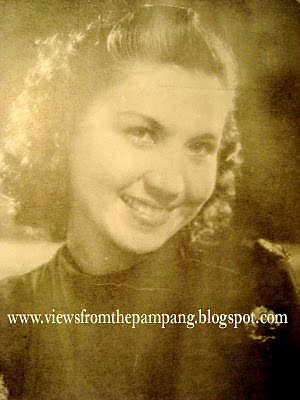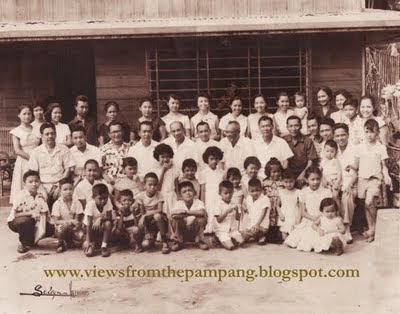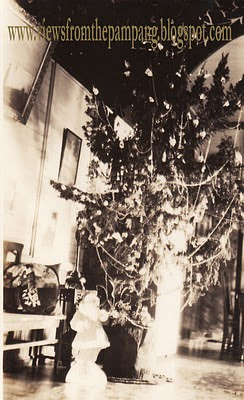 THE ART OF KHAN. Manuel Pabustan Urbano Sr., better known as Manuel Conde, is recognized as one of the greatest Filipino directors of our time. He is credited for introducing Philippine movies to the world via his 1952 epic, "Genghis Khan", the film that took Venice Film Festival by storm. Rare autographed picture, ca. 1950s. Author's Collection.
THE ART OF KHAN. Manuel Pabustan Urbano Sr., better known as Manuel Conde, is recognized as one of the greatest Filipino directors of our time. He is credited for introducing Philippine movies to the world via his 1952 epic, "Genghis Khan", the film that took Venice Film Festival by storm. Rare autographed picture, ca. 1950s. Author's Collection.When I started a career in advertising, one of the very first directors I met and worked with was Jun Urbano. It was the early ‘80s, and Jun’s reputation as topnotch director was already known in the industry, bagging plum assignments from major advertisers such as San Miguel Corporation, including the legendary Fernando Poe Jr. commercials for its beer brand. I was a fledgling copywriter for Magnolia then, and just had a series of TV ads approved for production. Jun Urbano was the one and only choice to shoot these ads. When I finally did meet him to discuss the storyboards, I was awed by the depth of his creative vision and artistic talent that obviously ran deep in his blood, being the eldest son of the famed director, Manuel Conde.
As we did more commercials together, Jun and I became fast friends. During shooting lulls, he would often talk about his father and how he was influenced by the cinema he created during the gilded age of Philippine movies. I was surprised to learn too that Manuel had Kapampangan roots, the son of an Italian mestizo, Dionisio Urbano, and Lucia Pabustan of San Fernando, a Pampangueña who relocated to Daet, Camarines Norte in her teens.
It was here that Manuel was born on 9 October 1915. He was preceded by elder sisters Nena and Carmen. Lucia and Dionisio ran a zapateria and a bibingkahan to support their growing family, but they would meet early deaths, leaving their three children orphans. The siblings supported themselves by selling banana fritters in front of movie houses and that was where Manuel’s interest in movies began.
After graduating from the Camarines Norte High School, he left for Manila to enroll in geological engineering at Adamson University in 1931. He would play hooky and hang around Filippine Films and in 1935, he was signed up to work for the film outfit as an all-around production man, handling everything from spotlights to wardrobe and even doing stunt work. He also dabbled in acting, the job he came to love most. His first bit role was in the movie “Sa Tawag ng Diyos” helmed by Carlos Vander Tolosa, courtesy of a recommendation from Don Danon (stepbrother of Rosa Rosal, another half-Kapampangan actress).
Manuel ended his studies at Adamson and opted for a stable job with Marsman and Co. In 1938, he married Julita Salazar, a beautician, with whom he would have seven children, all named Manuel. The only girl in the brood was named Manuela. While with Marsman, he continued to moonlight as a performer, this time as ventriloquist with Borromeo Lou’s vaudeville troupe. He bought a dummy doll and renamed him Kiko Tolosa. Since it was difficult for the ventriloquist to say “Urbano”, he changed his last name to “Conde”, giving birth to a screen name that he would always be known for.
His foray into directing was a result of a missed opportunity, when, in 1938, he missed his boat to Java where he had been taken in to work as a mining prospector because he got drunk the night before. Director Carlos Vander Tolosa found himself an assistant director in the person of Manuel Conde, and in 1939, their film, “Giliw Ko” was released. Recognizing his worth, the producer Doña Sisang de Leon offered him his first directorial job, “Sawing Gantimpala” an LVN super production in 1940. Thus began a flourishing career as a successful director of renown.
He was well-known for his costumed fantasies for LVN, including “Ibong Adarna”, “Principe Tiñoso” and “Principeng Hindi Tumatawa”, which was based on a story by Doña Aurora Quezon. He struck out on his own in 1947 by forming his own MC Productions and came up with the very popular “Juan Tamad” series, which poked fun at the post-war Pinoy foibles. He worked with the future National Artist and good friend Carlos “Botong” Francisco in designing the look of his films. He followed his first “laffterpiece” with “Juan Daldal (Anak ni Juan Tamad)", but continued doing swashbuckling fanstasies like “Prinsipe Paris” and “Siete Infantes de Lara” in 1950 where he introduced a Mabalaqueña ingénue, Gracita Dominguez, the first wife of Dolphy.
That same year, Manuel started “Genghis Khan”, a result of his fascination with the great conqueror of Asia. He played the title role, supported by Elvira Reyes as Princess Lei Hai. Manuel shot the movie on a modest budget of P125,000, renting puny calesa horses to save money and shooting in Guadalupe for the rocky mountain scenes. It was premiered at the Times Theater in Quiapo on 7 November 1950 and turned out to be a dud, closing after 4 days. It did win the “Most Popular Motion Picture Award” in a 1951-52 poll conducted by The Herald and Manuel himself would reap a slew of acting and directorial awards, that earned him a Hollywood trip as part of his prize.
This led to a screening of Genghis Khan in Hollywood and the reaction to his film was very positive. In August 1952, the film was submitted for consideration at the Venice Film Festival. From among 780 film entries, Genghis Khan was chosen as one of 20 films to vie for awards at the prestigious film fest, a first for the Philippines. Though it did not win, Genghis Khan made waves and emerged as one of the most popular movie of the annual festival. The movie would be exhibited later in Salzburg, and in 1953, was screened at the Edinburgh Fil Festival where, once again, it thrilled audiences.
United Artists bought the film for distribution around the world, where it would later be dubbed in 16 languages and earning 17 million dollars.
Returning from his triumphant conquest of Europe, Manuel made more hits for LVN and for his own film outfit like “Ikaw Kasi”, “Handang Matodas” (starring Nestor de Villa and Nida Blanca), “Bahala Na”, “Krus na Kawayan” and “Bayanihan”. But it was his second series of Juan Tamad movies filmed from 1959-63 that would prove his mettle as an effective political and social commentator through films. The 3 Juan Tamad classics, “Juan Tamad Goes to Congress”, “Juan Tamad Goes to Society” and “Juan Tamad at Juan Masipag sa Pulitikang Walang Hanggan” entertained audiences while making critical statements about local Philippine culture, challenging traditions and taking swipe at political and laughable social practices.
Two years after his last Juan Tamad film, Manuel ran unsuccessfully for congressman of the 3rd District of Manila. In 1973, his son Jun Urbano directed him in the remake of “Siete Infantes de Lara”. He was forced out of his retirement in 1974 to direct the Lapu-Lapu episode of the NMPC-produced “Tadhana: Ito ang Lahing Pilipino”, but the historical epic meant to flag the Marcoses’ New Society was never shown to the public.
“Juan Tamad” was resurrected briefly as a TV series in 1979 and the following year, he appeared as the elder Juan Tamad to Niño Muhlach in the film “Juan Tamad Jr.”. He was inducted in the Filipino Film Directors’ Chapter of the Artists Hall of Fame for his lifetime contributions. He likewise was given the “Patnubay ng Kalinangan Award” from the Mayor of Manila in 1984. Manuel Conde, the Filipino movie great who showed the way for Filipino films to win international acclaim, passed away at age 69 on 11 August 1985.
POSTSCRIPT: After a successful stint as a commercial director, Jun Urbano reinvented himself as Mr. Shoo-Li, the Mongolian TV character from “Champoy” that was obviously inspired by Genghis Khan. Like “Juan Tamad” before him, Mr. Shoo-Li made wacky commentaries about the Philippine socio-political scene and gained nationwide popularity just like his father’s creation.
(Source: The Cinema of Manuel Conde, Nicanor Tiongson, University of Santo Tomas Publishing House, 2008)
























